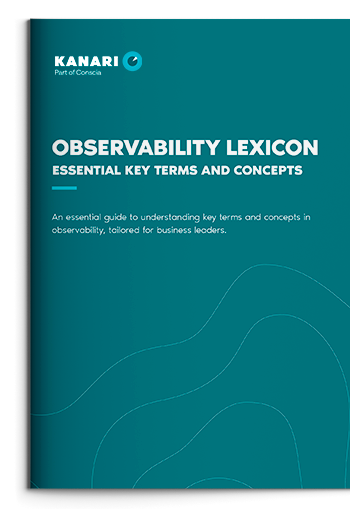NEW Observability Guide
Get it here‘Logs, metrics, and traces’? Sounds like a band.
It’s not. But it is the backbone of observability.
Subscribe to our newsletter and get the Observability Lexicon – your short, clear, no-nonsense guide to what it all means (and why it matters).

Complexity = satisfied customers?
The Growing Complexity of IT-Delivery Chains
IT-delivery chains are getting more and more complex month by month, year after year. Why? What drives this increased complexity?
An obvious initial thought that comes to mind is that companies are scared to be surpassed by their competitors due to a superior delivery and cost model.
The Drive for Innovation
Technology evolves, and “disruptive” innovations and improvements are announced more often than we change underwear. Increase efficiency, reduce cost, ensure compliance, reduce time-to-market, ensure stability, increase sales, improve quality … or something similar, are the typical business drivers of these innovations that “change the game.” At the same time, history reveals that most of the time, the “game” stays pretty much the same.
Skepticism Towards New Technologies
Decision makers across the globe have naturally developed a skepticism towards most everything new or “disruptive” within technology. Healthy questions such as "Which business problem will this solve for me short-term/long-term?" and "What is the total cost of ownership?" are generally considered. However, some questions are not necessarily given as much thought. Questions like:
-
Will adapting this technology increase the complexity of my IT-delivery chains?
-
Will it end up being too complex?
-
Will it improve my delivered quality?
-
Which facts do I have and trust to make a decision?
-
Will this technology truly replace anything?
-
Is my organization mature enough to utilize the new capabilities?
-
Which processes do I need to change to maximize the return on my investment?
These questions would need a column each to discuss them properly, but we would like to focus on complexity.
When Does Complexity Become Too Much?
We consider a delivery chain to be too complex if it consists of more moving parts and components than required to meet the actual need to fulfill its defined purpose. Further, we consider the user and customer expectations and desires as central in the assessment of the actual need.
Most delivery chains exist to ultimately provide some business functions to users and/or customers. One has the experience and knowledge to define the required business functions at a given time based on the supposed user need and expectation. Adapting an innovative technology that reduces the administration cost of a service by 25% might sound like a no-brainer, but what if this means that the time spent troubleshooting serious issues increases by 50% due to the increased complexity? The indirect cost of such a case may far surpass the direct cost savings, which often is the business case of any “improvement” or technical innovation and product.
Understanding User Expectations
Expectations and desires of the users can be monitored because we can observe what they say, and with the right tools, competence, and processes, what they do. That way, it is easier to understand which new “disruptive” technologies might be worth investigating and to be confident when deciding on a strategy for your IT-Services.
Maybe it is time we start analyzing the “whole picture” when we consider adapting technology. In addition, we should make sure that it directly serves user expectations without heavily adding cost.
We think focusing on meeting the expectations of your users and customers will have a huge benefit in the long run.